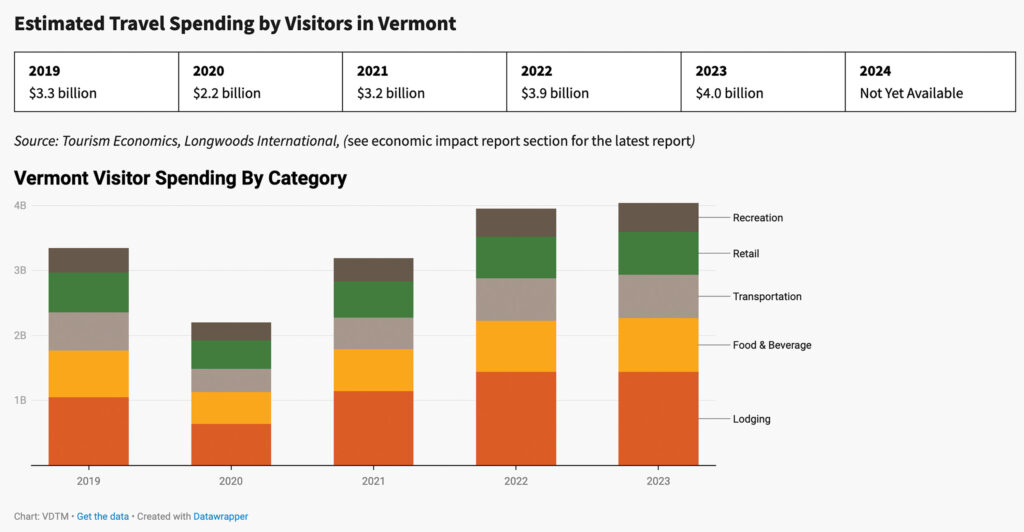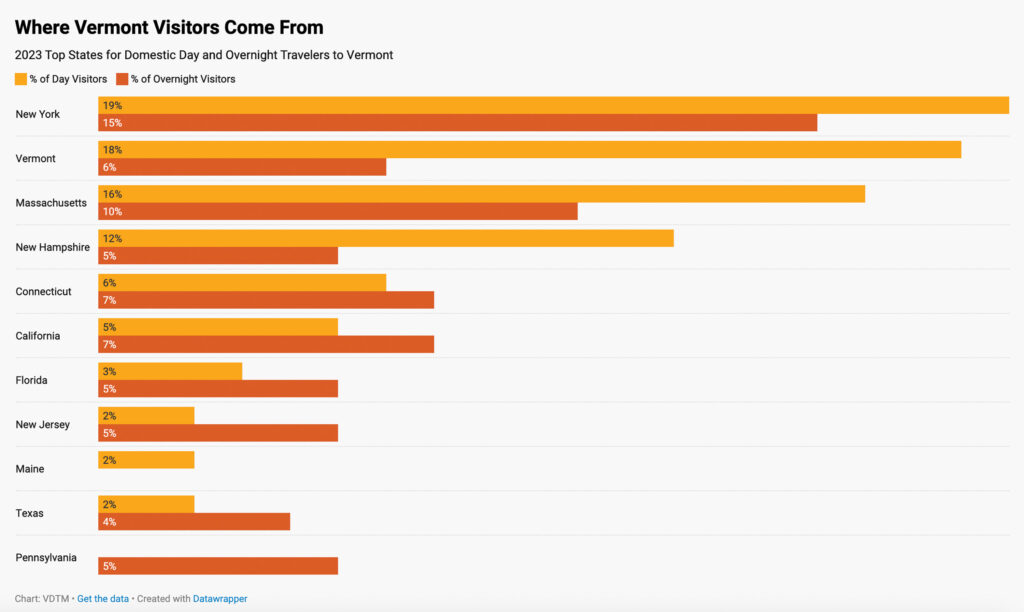The Vermont Department of Tourism and Marketing (VDTM) is announced Jan. 27, the results of a study by Tourism Economics that finds visitors to Vermont in 2023 spent a record $4 billion on goods and services. Researchers also found that 15.8 million guests came to Vermont in 2023, showing a sustained return to pre-pandemic visitation.
“Tourism has always been important to Vermont, but this new data underscores tourism’s role in driving the economy in every corner of our state,” said Commerce Secretary Lindsay Kurrle. “To sustain and grow this impact, we must support our businesses and workers who provide the experiences that make Vermont unforgettable, while inspiring visitors to get off the beaten path. By discovering the hidden gems and unique experiences in every region, they’ll uncover what truly makes Vermont so special.”
According to the report, “Economic Impact of Visitors in Vermont 2023,” visitor spending represents 9.3% of Vermont’s Gross Domestic Product (GDP), which is significantly higher than the national state average of 3.0% (2022 data).
It also found the visitor economy supports 31,053 jobs, which is 9% of Vermont’s workforce.
When it comes to direct spending, tourism contributed:
$1.4 billion for lodging
$830 million for food and beverages
$658 million in retail spending
$581 million for gasoline and other transportation
$446 million for recreation and entertainment
$282.3 million in state and local taxes, the equivalent of $1,048 per Vermont household.
“When we think about economic impact, it is helpful to think of our guests as temporary taxpayers,” said Tourism and Marketing Commissioner Heather Pelham. “This data reinforces that tourism is a huge economic driver in the state of Vermont. Every guest who buys a meal, spends the night, or hits the slopes is helping our businesses thrive, putting Vermonters to work, and benefitting our communities by paying taxes that help fund essential services and quality-of-life initiatives.”
This study was made possible thanks to a grant from the U.S. Economic Development Administration. This unprecedented examination provides a baseline against which VDTM can track future tourism trends. It also provides access for the first time to county-specific data that can be used to better understand regional differences.
The data also examines employment by county. Every county in Vermont employs people who work in the tourism sector. In Windsor County, 10% of jobs are supported by the visitor economy.
“The 70,000 annual visitors to Billings Farm & Museum provide an important economic driver for our region, sustaining jobs in hospitality, at area restaurants, and in local shops, and markets,” said David Simmons, executive director of Billings Farm & Museum. “Woodstock has been a tourist destination for a century and a half and today offers the quintessential Vermont experience, including abundant opportunities for outdoor recreation, a vibrant historic village, and the chance to see a working dairy farm in action.”
Tourism Economics will provide a follow up report for calendar year 2024 by mid-2025.
For more info, visit: accd.vermont.gov/tourism/research.

Courtesy VDTM
Chart shows that the estimated number of visitors to the state has rebounded after seeing a dip during the early Covid years.

Courtesy VDTM
Charts show the spending over the past five years by category hit a record high in 2023. Spending by category was roughly the same proportionally with lodging making up the bulk of the spending.

Courtesy VDTM
The charts shows visitation numbers for camping, a popular activity in the summer, and skiing, a big draw to the state in the winter. The numbers for last year, 2024, show that it was about average for the six year span.

Chart shows where most of Vermont’s visitors come from and how that coorelates with overnight stays. Predictably those that travel from further away states are more likely to spend the night but the trend varies greatly by state.




